I’m going to state up front that I really wish Per Aspera had turned out differently. My last few reviews have been reasonably negative, and contrary to appearances I don’t like slating bad games all that much; at the very least it becomes exhausting to do it five or six times in a row, so I was hoping that Per Aspera would break that streak. More to the point, though, is that I have been waiting the better part of two decades for somebody to make a game about terraforming Mars. Per Aspera should have been extremely my jam. It definitely looked extremely my jam when I played the demo, with all of the levers I was expecting like modifying atmosphere content, raising the temperature, melting the ice caps and so on. Finally, I thought, somebody has made the terraforming game that Surviving Mars wasn’t, and which Terraforming Mars was a bit too light to really satisfy my urge for1. I tinkered for around twenty minutes and then put the demo down, not wanting to have to repeat (or spoil) myself too much when I played the full product.
In retrospect this may have been something of a mistake, because if I’d played that demo for just a bit longer I might have noticed that Per Aspera is the most broken game I’ve played this year.
I really need to qualify that statement, but in the opposite direction to what people usually mean when they say they need to qualify a statement. It’s telling that when looking back over the last couple of years of reviews the only ones which don’t include a phrase along the lines of “this was rushed out the door with no time for polish or bugfixing” are the games which I’m coming to a year or so after their initial release, or which spent a significant period of time in Early Access to hammer out all of the kinks — I used to be quite down on the concept of Early Access, but I’m coming around on it now simply because Early Access games are honest enough to clearly label the fact that they are unfinished. Releasing your game in a semi-broken state and then polishing it up over the next 3-6 months is the new normal for the industry, but even when nearly every videogame is stuffed full of bugs to a greater or lesser degree Per Aspera stands out from the pack in just how broken it is. Nothing in the game works properly, to the point where it’s just on the cusp of being unplayable, and that I managed to struggle to the end of the campaign is down to combination of my professional experience in debugging and working around broken systems, a regrettably intimate knowledge of how bad game designers operate so that I can anticipate the dumb shit the game is about to pull, and sheer bloody-mindedness. So when I say “Per Aspera is the most broken game I’ve played this year”, I don’t just mean “Wow, there sure are a lot of bugs here!” because that would be sadly unremarkable; what I’m actually trying to say is that Per Aspera is almost not fit for purpose as a functioning videogame.
Per Aspera is set a couple of hundred years in the future and has you playing an AI called AMI who has been sent to Mars with a single purpose: to make the planet fit for human habitation. You start by raising the temperature to melt the ice caps and liberate trapped CO2, creating a weak atmosphere. Then you build biodomes which generate lichen that can survive in low-oxygen environments; the lichen converts the CO2 into oxygen, and the increasing oxygen content raises the temperature. It won’t increase it enough to remain above freezing, however, so you need to supplement it via some additional methods such as building space mirrors to reflect sunlight down onto the poles, shipping in greenhouse gases from Earth, or by the simple expedient of crashing a comet into the planet, which generates a lot of kinetic energy. You need to thicken the atmosphere somehow, which means either cracking additional CO2 out of the regolith or else aerobraking a nitrogen-rich asteroid into the atmosphere, or even transporting it all the way from Titan. Eventually you have an atmosphere with over one bar of pressure which is around 27% oxygen, 73% nitrogen and zero carbon dioxide — i.e. breathable by humans — a surface temperature which might be a little chilly but which can be endured with a thick coat rather than a full-on environment suit, and a science-fiction shielding system in orbit that creates an artificial magnetosphere to prevent all of that nasty solar radiation from reaching the surface and shredding your colonists’ DNA. And the moment humans can walk unprotected on the surface of Mars is the moment that you can say your terraforming mission is finally complete.
So, that’s the goal. The method is, alas, considerably more prosaic; Per Aspera is a colony building sim very much in the vein of The Settlers 2. You start with a single landing site with a few nearby resource nodes, and a single worker drone. Put down an aluminium mine on the nearest node and your worker will transport construction materials from your landing site to the construction site. It does this one block of material at a time, so a building that takes three aluminium and three glass to build will require six separate there-and-back trips. Once all of the construction materials have been transported the worker will then proceed to build the mine, which will start autonomously producing aluminium once it’s finished. You follow this up with a silicon mine and a glass kiln for converting the silicon into glass, and then a carbon mine, iron mine and steel foundry for making steel, and then an electronics factory and a parts factory. With each successive building your single worker becomes increasingly overloaded since it has to deal with the input and output of each building as well as transporting materials for each new building you construct, but you cannot build a worker drone factory to make new workers until you have this basic supply chain set up, so you’re doomed to spend the first 30 minutes of the game in this single-threaded state just waiting for things to happen. And even on the 16x speed setting, this takes a long time.
Aside from the general state of brokenness this is the standout attribute of Per Aspera, I think: it is a very slow game, and not in the way you’d expect a game about terraforming Mars to be. Terraforming as a process is something that will take centuries at best (Per Aspera rather optimistically thinks we can get it done in just a few a decades), but timescales in strategy games are always somewhat arbitrary2 and there’s no reason you can’t have those centuries take place over, say, twenty hours of in-game time that are backed by a robust set of gameplay mechanics where you’re actively doing stuff to hurry along those terraforming targets. Terraforming being slow does not mean Per Aspera has to be slow, but slow it is; there’s very little that you can personally do to make things happen in this game aside from plonking down new buildings, and so you’re reduced to just watching worker drones move things around while waiting for something to be built or for a project to complete or a milestone to be hit. Ideally you could just run the game at 16x speed the whole time and it would be bearable, but this isn’t really a viable approach for reasons that I’ll go into in just a moment, and so far too much of your time in Per Aspera is spent doing absolutely nothing.
Now, you would think that things would at least speed up once you got your worker drone factory up and running — after all, if you have one drone doing all of the work, then surely adding a second drone will make that work happen in half the time? Well, this is where we come back to the reason I specifically namedropped The Settlers 2 as a comparable sort of resource generation/processing game, because the way the worker drones operate in Per Aspera is pretty similar. If you’ve played Settlers 2 you might recall the slightly obtuse method of resource transportation, where buildings would be separated by long stretches of roads with a worker stationed on each one. To transport a resource along the road the worker would have to walk to one end, pick up the resource, walk to the other end, and then set it down. This obviously took a long time if you had a long road and single worker, which is why Settlers 2 allowed you to plonk down magic flags that subdivided roads into segments running from flag to flag, each with its own dedicated worker. Doing so had zero cost to you since the workers spawned out of nothing, so the best way to optimise the supply chain was to jam as many flags onto a single stretch of road as possible and have the workers shuttle resources from one end to the other in a long bucket chain — this way the first worker can go back and pick up a second resource while the second worker is transporting the first one, and so on down the chain, and you get a linear increase in efficiency with each worker you add to the road.
Per Aspera’s workers function much the same way, except where The Settlers 2’s worker system was weird but usable, Per Aspera’s is just a complete fucking mess. There are two key differences here:
- Instead of having responsibility for a single road or road segment, Per Aspera’s workers operate out of worker hubs. Each hub has a single worker along with an area of responsibility for that worker that you have little control over — it’s automatically generated when the hub is placed, and updated when new hubs are created nearby, but you cannot ever set the boundaries yourself. Each hub’s worker will transport resources across its work area to an adjacent one, or to buildings inside of its work area, but if you have two adjacent workers and one of them is dealing with a massive resource bottleneck and the other is 100% free, the second worker will not lift a single robotic finger to help out unless the resources need to travel across or into its own work area — this means that adding a second worker does not lead to anything like a twofold increase in efficiency, and may not speed things up at all if its automatically-generated work area does not include any resource production or processing buildings.
- You do not manually build roads in Per Aspera the way you did in Settlers. Instead when you place a new building the game will automatically create new roads from that building to every single nearby building. Given how things work in this sort of resource collection and processing game, where you want your processing buildings to be placed close to the production buildings, and the buildings that consume those processed resources as close to the processors as possible, you naturally end up creating areas of high density where a single new building ends up with nine or ten roads spiralling off of it. This creates a pathfinding nightmare for the worker drones, not to mention making your colony look ugly as sin.
Because individual workers are responsible for multiple buildings and roads, and because there are so many more roads in Per Aspera, the resource transportation system that you are building is exponentially more complex — and you have no control over it. You can’t tell drones where to go or what to pick up, you can’t set their work areas, and you can’t even decide where the roads go beyond trying to place your buildings so that you don’t spam too many of them. If you end up with a bottleneck in one place all you can do is add additional worker hubs nearby (which incidentally creates even more roads) and hope that this will shift the work areas in such a way as to relieve the pressure. The only lever you have for indirectly affecting a drone’s decision making is a high priority toggle for individual buildings, which is an incredibly blunt instrument — not to mention quite ineffective when you have fifty buildings all on high priority at the same time and you can’t take them off because otherwise it’ll have knock-on effects on other parts of your supply chain.
The obvious consequence of not giving the player any control over the behaviour of worker drones is that Per Aspera is incredibly, absurdly reliant on the quality of its worker drone AI to make the right decisions regarding what to transport and where. And it will probably not shock you to learn that the worker drone AI is some considerable way off of being the logistical genius it needs to be to handle a system that eventually spreads out to encompass a thousand buildings spread across half of Mars’ surface. Once you understand how the worker hubs actually function it is at least adequate for keeping things running smoothly when you only have around a hundred buildings; however, past that point you’ll start to notice weird pathfinding bugs starting to gum up the works, like workers taking a pointless detour to a node that’s effectively a dead end and then turning around and going back the way they came, or constantly shuttling the same resource back and forth between two nodes without ever moving it onwards towards its destination, or just getting stuck outside of a building with nothing you can do to move them onwards — you’ll need to quit and reload the game in order to reset the pathfinding. As you scale up further it gets worse and worse, refusing to transport food from a water extractor to a nearby colony even though you have both the water extractor and the colony on high priority, or deciding it’s incredibly important to create a stockpile of 50 carbon on a random solar plant without ever moving any of that material onwards down the chain. And once you have taken up an appreciable fraction of the surface of Mars you’ll notice that the logistics system doesn’t take distance into account when assigning resources to a building — when it is looking for, say, 30 Food to feed a colony, it doesn’t tag the 30 Food that you have in the nearby food factories you specifically set up to feed that colony but will instead decide to transport Food from the stockpile next to one of your colonies on the other side of the planet, placing even more strain on your transport network and potentially causing the colonists to starve if the drones run into any trouble along the way.
Finally when you get to the point of tackling the endgame projects the logistics system breaks down entirely; these projects involve transporting hundreds of resources to Spaceport buildings so that you can build Space Elevators, and then transporting hundreds more resources to the Space Elevators so that you can launch the magic radiation shielding satellites. Nearly every single time I tried to complete one of these projects the logistics system would very slowly fill a Spaceport to 99/100 of a required resource — the resources might encounter bugs and blockages and they might come in from really inefficient source locations, but they would eventually turn up if given enough time (in some cases, years) — but would then refuse to add the last one. You can click on a building to find out where incoming resources for it are currently located, so I could see where the last piece of carbon my Space Elevator required was; it was at a hyperloop3 terminus a couple of jumps away. I watched workers move other resources through the terminus for in-game months without ever touching that carbon. The logistics system had seemingly forgotten about it, and because I had no tools to interact with it there was no way for me to jog its memory, and so the Space Elevator was doomed to remain on 99/100 carbon forever.
(So if I kept running into this bug, how did I finish the game? Well, the answer is very simple: I had to turn off every single building that wasn’t directly involved in keeping my colonists alive so that the only resources being transported across my network were food, water and the resources for the Space Elevator, as this reduced the load to something that the logistics system’s primitive rock brain could handle. Doing this required me to pull up an unfiltered list of all 1,000 buildings in the game — something which the game took nearly a full minute to generate, which really makes me wonder how the hell it’s storing its data — and then turn off the 500 that I didn’t need, one at a time. It would have been nice to play a game where I didn’t have to spend fifteen minutes toggling a big list of power buttons in order to complete it, but that would mean having a logistics system that wasn’t a buggy piece of crap or which I could control in any other way other than the blunt hammer of just turning everything off.)
It’s because of these bugs creating totally unnecessary inefficiencies and blockages in my transportation system that I felt like I couldn’t afford to run the game at 16x speed. Instead, for most of my time with Per Aspera I was running at 4x at most so that I could catch things like my worker drones spontaneously deciding that my colonists didn’t need water any more before they all died, which only served to heighten that feeling of waiting around for something to happen. This general feeling of boredom isn’t helped at all by the incredibly flat building tech tree — you know that chain of buildings I described earlier leading up to building a worker drone factory? You build all of that in the first twenty minutes of the game, and it turns out that this set of buildings represents nearly all of what you build for the next thirty hours too. There are six raw resources in the game — aluminium, iron, silicon, carbon, water and chemicals — and six kinds of processed resource — electronics, parts, food, glass, steel and polymers — and you will have set up a supply chain for all of them by the end of your first hour with Per Aspera. Past this point the gameplay just consists of plonking down the same sets of buildings over and over again; there’s nothing you can research that introduces a new resource stream or fundamentally changes the way you collect or process them, just a set of boring technologies for “Mine Mk 2” and “Mine Mk 3” that output the resources a bit faster.
Most bafflingly of all, there’s not a single facet of the game where your terraforming progress enables new systems and methods of resource gathering. For example, at the start of Per Aspera, when Mars is still a frozen ball of rock, you gather water by drilling it out of underground ice deposits that show up on the map as Water resource nodes. However, one of the first visible effects your terraforming efforts have on Mars is the melting of the polar ice caps, which creates a large ocean covering the northern third of the planet. You would think that this would make gathering water a much simpler process, especially because all resource nodes are finite and any attempt to scale up your colonist numbers is severely bottlenecked by the amount of water you can produce at any one time along with the ever-present threat that you might run out and have everyone die of thirst. But there’s no Water Purifier building in the game, no way to extract water from the inexhaustible supplies present in Mars’ brand new oceans; even at the end of the game when Mars is almost fully Earth-like you’re still getting your water by drilling it out of the planet’s crust. The same goes for Food, which is produced by combining the Water and Chemicals resources together in a food factory; despite building biodomes which spread radiation-resistant biomass across the surface of Mars there’s no way to actually grow your own radiation-resistant food crops at the same time, and so it’s food factories all the way down.
Now, it’s possible that my colonists were all bottled water connoisseurs who refused to drink anything that wasn’t the Mars equivalent of Evian, but I doubt it. Per Aspera has no sense of attaining mastery over the environment, that the terraforming process is genuinely making Mars a more liveable place for humans. Instead the effect your terraforming efforts have on Mars is almost purely cosmetic; the in-game consequences are limited to rising sea levels eating buildings (very easy to work around because you have complete control over how fast this happens, or if it happens at all) and an increased maintenance cost when the proportion of oxygen in the atmosphere goes past 30% and all your buildings start to catch on fire. Other than this, the gameplay on a fully-terraformed and colonised Mars is exactly the same as the initial robot pioneer stage: you build resource production and processing buildings along with a few spaceports and worker drones shuffle resources between them in an extremely buggy and inefficient manner. That’s it. That’s the entire game. This is Per Aspera’s biggest failing as a set of gameplay systems, I think — sure, most of them are broken in one way or another, but even if it all worked as intended the fact that it’s a game about terraforming Mars where the terraforming process doesn’t actually feed back into the core gameplay loop in any meaningful way is an absolutely enormous flaw in the concept. It really does reduce it to watching for any screwups by your worker drones while a series of numbers slowly tick up in the background — first temperature, then sea levels, then oxygen pressure, and then atmosphere content, but they’re all just numbers and nothing more. And if I wanted to spend my time looking at a meaningless number tick up I would just go and dump another week into Cookie Clicker.
Unfortunately for Per Aspera, that damning indictment isn’t remotely the end of its problems, because now that I’ve explained the problems with the core gameplay — that it is long, that it is boring, and that it never changes — I can really start to get into how it is quite fundamentally, unbelievably broken. I have already covered the fact that the logistics system isn’t fit for purpose, which is the most conspicuous set of bugs by far because it’s 90% of what you deal with in this game, but no matter where you look you’ll find that everything’s just as busted, if not worse.
For starters the terraforming numbers have all been sketched out on the back of an envelope without any serious thought as to how they’ll actually play. There are two broad methods available to you for terraforming Mars: constructing buildings which slowly generate whatever number it is you need at the moment — a building which belches out greenhouse gases, or which cracks CO2 out of carbon deposits, or which burns water to create oxygen — or doing one-off space-based projects that take a while to complete but which yield a big lump sum of the needed number when they finish, like aerobraking a nitrogen asteroid into the atmosphere. The first space project you get is scattering black dust over the poles to gradually raise the albedo and melt them more quickly. I’d built a couple of greenhouse gas plants but they were raising the temperature by a fraction of a fraction of a degree every year, so I decided to try the black polar dust — only to discover that a single build and launch of this was enough to instantly melt the poles. It was like flipping a switch; one day the north pole was solid ice, and the next there was an ocean covering one-third of the planet’s surface. Aerobraking a methane asteroid had similar results; sure, I could build twenty GHG plants and wait for them to slowly raise the temperature, but why would I bother when a single methane asteroid instantly boosts it by a whopping twenty degrees Celsius? For comparison there is also a project to launch a constellation of space mirrors to reflect light onto the poles; the mirrors are very expensive in comparison to the asteroid and you can build up to fifteen of them. A full fifteen-mirror constellation, which takes most of the game to finish, will raise Mars’ temperature by just ten degrees — half the amount of a single methane asteroid for twenty times the cost and twenty times the time investment.
In mitigation I think the asteroids are supposed to be one-offs since they disappear from your available projects list once you’ve done them. It makes sense to attach larger numbers to them if this is so, even if it doesn’t make sense that you can only find a single methane- or nitrogen-rich asteroid in the entire Solar System. However, if they are supposed to be one-offs then they’re bugged because they reappear in the available projects list every time you load a save — this completely obviates the need for really long-term projects like shipping ice in from Europa or nitrogen from Titan, because you can just repeatedly chuck asteroids into the atmosphere for much more immediate results.
(Of course, doing so requires you to repeatedly use the space projects interface which is one of the most gratuitously slapdash interfaces I’ve seen in a videogame, with consistently misaligned and mis-sized text and buttons which do absolutely nothing when you push them. There’s zero feedback on anything you do in there, so you don’t get a notification when a project is complete, or even a visual flourish like a pan and focus on the big asteroid now flying through the atmosphere; it just ticks over and finishes silently with none of the fanfare you’d expect from Per Aspera’s Wonder equivalent. Some projects like the cargo ships naturally repeat, but others like the space mirrors do not and there’s no way to queue them up, and so if you’re not paying attention your spaceport will finish launching a project and then just sit there idle until such time as you notice it’s doing precisely sod all, which is yet another reason you can’t just click the 16x speed button and enjoy the game at a somewhat bearable pace. Trying to cancel a project is a nightmare if it’s in a noncancelable phase because you click the big X button in the corner and nothing happens, with no UI popup or message telling you what you’re doing wrong. And finally, and most unforgivably of all, there’s no in-game difference between a Space Elevator and a Spaceport. Space Elevators do not do anything aside from enabling the magnetic shield project required to complete the game, which is a bit much when finishing a single Space Elevator requires you to complete the Space Elevator project 12 times. Not that the game will tell you this either; you’ll finish it the first time and then wonder why nothing has happened because the UI detail telling you it’s a twelve-part project is awful.)
These wildly unbalanced terraforming numbers play merry hell with Per Aspera’s event and dialogue triggers. Per Aspera rather unwisely decides to communicate most of your terraforming choices and feedback not via gameplay mechanics or even visual effects, but instead by having people call you up on the phone and shout at you. There are a couple of plot threads going on, with the main one being an unoriginal exploration of the nature of AMI’s AI consciousness that has been directly ripped off from season one of HBO’s Westworld. However, the dialogue won’t fire until you hit certain terraforming thresholds or colonise certain areas of Mars, and because the various methods of terraforming are so broken you can end up completely breaking the dialogue system by completing a single terraforming project that catapults you past all of Per Aspera’s carefully planned dialogue triggers.
An example: there is supposed to be a whole in-game debate with the leader of the colonists about whether you should use nuclear weapons you found in an old Chinese base to melt the polar ice caps quickly, or instead take your time and not liberally scatter fallout across the surface of Mars. To follow this plot thread you need to build research outposts on a series of abandoned bases until you find the nuclear silo and then, presumably, decide whether or not to do the “Nuke Poles” project. This process, like so much in Per Aspera, is supposed to take a very long time since the intended path is that you build two or three additional, independently functional bases to support the research outposts, which are scattered across an entire hemisphere. There’s probably a ton of dialogue triggers in there as that debate and plot thread progresses — but I never saw them, because the Black Polar Dust project ended up one-shotting the ice caps and melting them overnight, and the colonist leader proceeded to complain at me for using the nukes even though I hadn’t even found them yet. For years after this happened I got random bits of dialogue from AMI ruminating over the morality of using the nukes despite the ice caps being long gone, and this wasn’t an isolated incident. Past the first couple of hours of the game I don’t think I saw a single piece of dialogue that fired at a sensible time — it was all either referring to stuff I’d already blown past ages ago, or else talking about things that I’d never even done because I’d skipped the triggers for it. It’s yet another thing in Per Aspera which is a complete mess, and this is particularly weird considering Tlön Industries are heavily trailing the involvement of big-name voice actors like Troy Baker and Phil LaMarr; if they’re spending that kind of money you’d think they’d at least take care to ensure that the dialogue system works instead of spewing out this totally incoherent nonsense.
It gets worse once you realise that the terraforming numbers are also linked to campaign event triggers which are also misfiring in hilarious fashion. The worst example of this — although far from the only one — is when you raise the temperature to above the threshold for Stage 2, which you can do very early on by aerobraking a single methane asteroid. You get a message from the colonist leader congratulating you on hitting your temperature target (one of the few dialogue triggers that actually works properly) and then as soon as the message ends you are immediately hit out of nowhere with a scripted event that reduces all of your buildings’ HP to 50%. There’s no buildup to it, no in-game effect, and not even a gap between the messages you receive; the colonist leader flips instantly from “Good work AMI, another step on the long road to a green Mars!” to “OH GOD EVERYTHING’S ON FIRE HELP!” with no explanation or context for how you got there. And then it turns out that the reason Per Aspera is taking a hammer to your base with nothing you can do about it is because it’s about to introduce its totally braindead combat system — this is a game about terraforming Mars, why is there even a combat system?!? — and the only way it can make it a challenge is if it pushes you to the edge of a death spiral. Buildings with reduced HP have their production rate reduced, so smashing your entire base down to 50% HP at once can bust your power output and supply chains to the point where you can’t recover in time to weather the enemy attack. I really hate games that are so poorly designed they have to give the player an unfun handicap in order to make something challenging, especially when that handicap is linked to a trigger that can be fired long before the player is ready for it because none of the numbers in this game were proofread before it was rudely shoved out the door.
There’s a ton more stuff I could get into if I wanted, like the fact that you’re researching blind with no idea what half of the techs or buildings do because the game won’t tell you, or that it’s not just the terraforming numbers that have been written on the back of a napkin over lunch and then input directly into the game with no sanity checking (you can have up to 100,000 colonists on Mars, except with a base covering half the planet I was struggling to feed 6,000), or that you have to terraform via a process of trial and error because it refuses to attach output values to anything forcing you to infer them yourself by watching those all-important terraforming numbers to see how fast they’re going up or down, or that even the music doesn’t work properly (it never switches track except when an event trigger fires, and because the event triggers are all broken you end up listening to same sixty seconds on a loop over and over again, for hours, until you go insane), but I think I’ve made my point. Nearly everything in Per Aspera is broken, and the stuff that isn’t has such a wonky implementation that it might as well be. It needs at least another six months of work until it’s playable, and while I’m more sympathetic to indie devs pushing stuff out the door far earlier than they should have because of budget/resourcing problems that sympathy stops at the point of most of the game just flat-out not working. And even if they do fix all of the bugs and balance all of the numbers and replace the logistics system with a smarter alternative, like a potato or something, Per Aspera will still have that one key flaw running through it: that it fails to feed its terraforming conceit back into the game mechanics, and ends up feeling like a particularly sterile boardgame that doesn’t even attempt to play to its theme4 and where you just do the same thing over and over again, for thirty hours. I see these problems quite a lot, but I don’t usually see them all packed together into the same game; on paper Per Aspera couldn’t have been more relevant to my interests, but in practice it’s nothing more than a tremendous disappointment.
- This is not the fault of Terraforming Mars, which is a good boardgame precisely because it keeps things light and abstracted enough for a small group of people to grasp and play in a couple of hours. ↩
- In particular I’m remembering Two Point Hospital, where it took a couple of weeks of in-game time for somebody to walk into reception, take a number and sit down in the waiting room, and this did not really hurt the game at all aside from a slightly raised eyebrow on my end. ↩
- Per Aspera’s unfortunate choice for a long-distance fast transportation system. If it had been made last decade it would have been something more sensible like a maglev network, but it seems like every game about space exploration that comes out these days has its tongue stuck firmly up Elon Musk’s backside despite his being one of the most thoroughly unpleasant human beings on the planet. ↩
- My go-to example for this is Lords Of Waterdeep, which has zero time for pretending it’s about anything more than collecting and spending coloured cubes. ↩

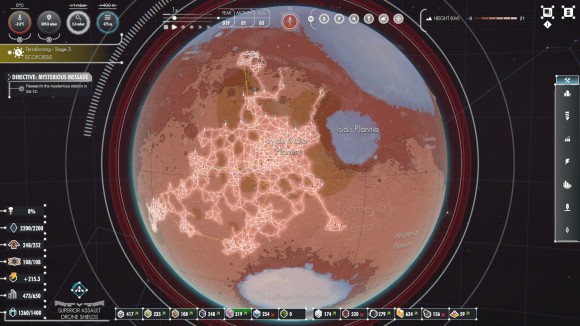
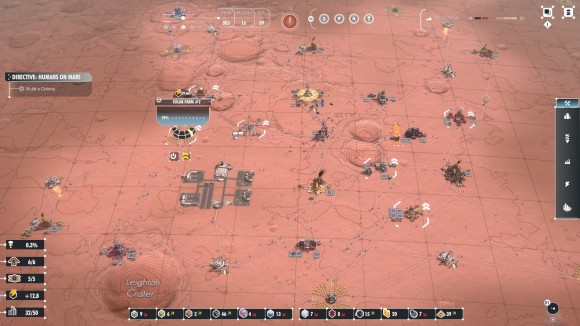
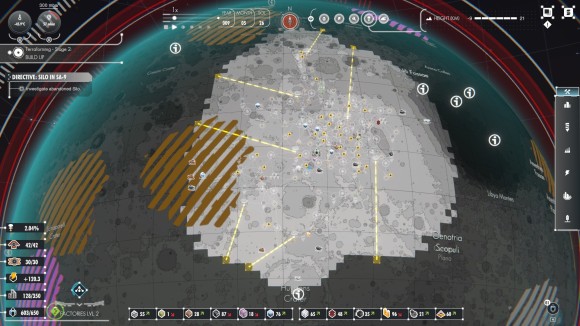
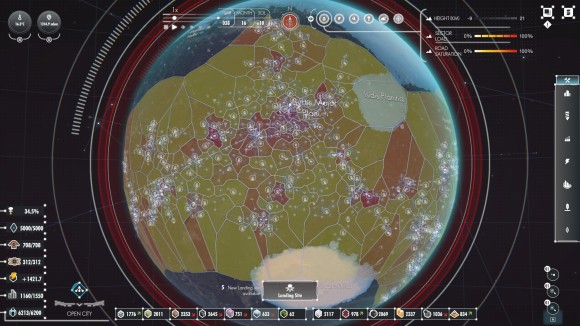
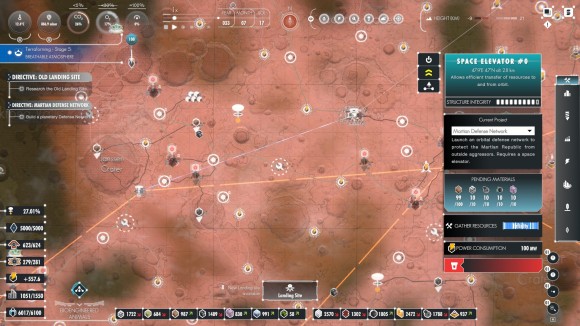
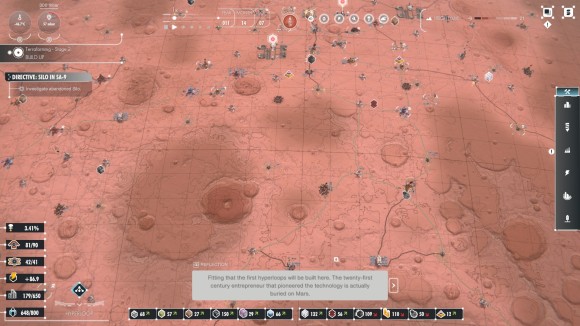
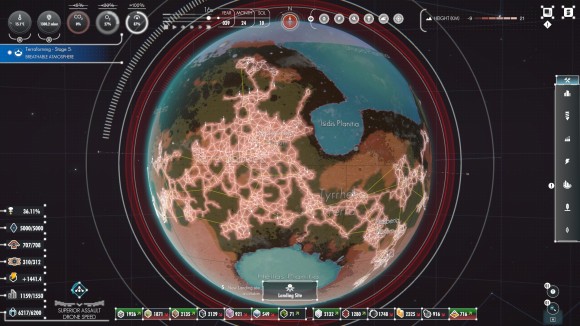
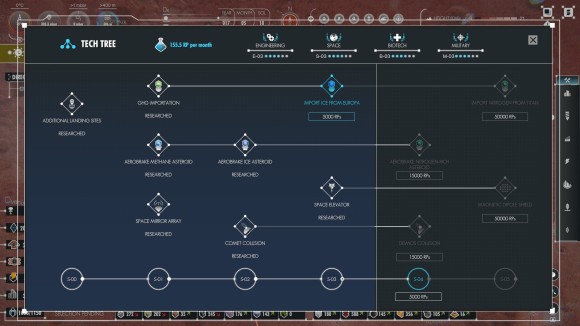
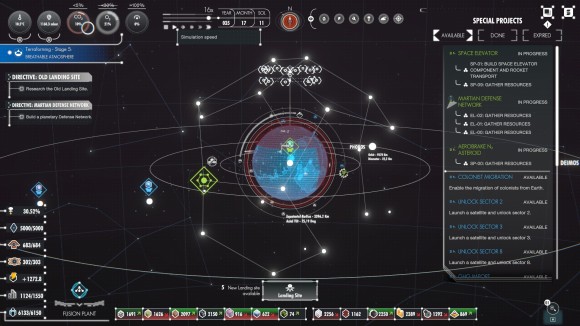
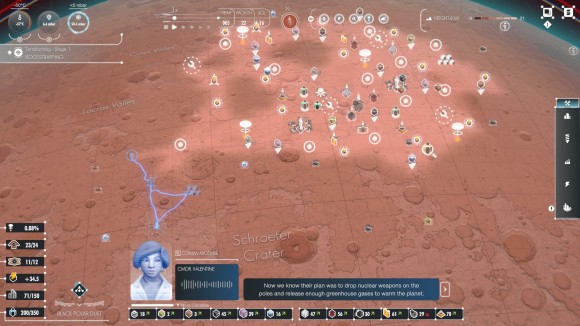
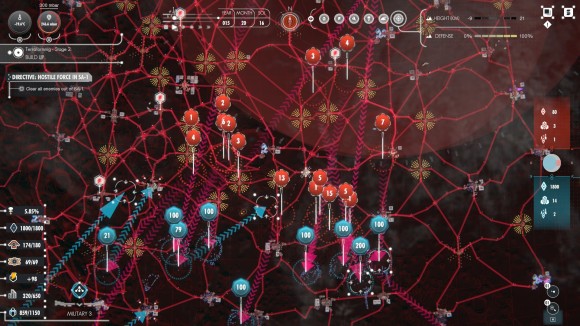
I am also bummed by this review, since a PC Gamer piece on this game put it on my radar as a potentially interesting experience.
Have you played the terraforming expansion for Surviving Mars? I won’t claim it completely changes the experience or solves its basic flaws, but it does make it a much better game, and it’s really satisfying to see the planet slowly become moist and green.
How in the world did you make it through the entire game? ???? ????
This was a glorious and entertaining read. Thank you.
I wish I had found your review earlier. Started a new campaign yesterday to see what the updates had fixed and had to quit cuz the pathfinding sent me on a death spiral after 40+ years. There are some mostly visual QoL improvements (And now there’s a water processing plant, I think they read your review) but still boring watching numbers go up. This was a good read.
i got to the end and after nothing happened i googled why finishing terraforming does nothing and was brought here, i can agree with a lot stated here and even though several issues appear to have been fixed from my playthrough, its a disappointment.
Reporting in from the glorious future here in 2022: many of the issues you name don’t match my experience playing this game this week.
My enormous logistics network doesn’t seem to get stuck and starve things unless I demand too much throughput from a single worker zone (though I do observe some apparently purposeless driving-resources-in-circles sometimes). If something’s starving, it’s almost always simply that I’m not making enough of its inputs. I’ve never seen the “gets stuck at 99/100 resources” issue (though I haven’t built space elevators yet).
Terraforming does now unlock some new gameplay:
- you can build water treatment plants on the edges of oceans, and you use the resulting piped water to supply several buildings that accept only that form of water and to make unlimited ice for buildings that need it
- you get less expensive/fiddly options for making food as the planet becomes more habitable (building farms in craters, then open-air farms)
- you can still mine the resources after the ocean covers them by building ships/ports, a logistics system that works differently from any of the previous options
- once the planet is warm enough and has enough atmosphere, you can start planting vegetation, which provides tons of oxygen for free but also poses an interesting management challenge because you can’t simply turn off the trees if you have too much oxygen
The UI remains kind of clunky, but I don’t think I’ve seen any of the flagrant bugs you report.
All of the “repeatable” space port projects I’ve seen can automatically repeat now, including satellite launch.
Issues that are definitely still present:
- game pace is still slooooow, even running at 16x the entire time
- different options for terraforming (asteroids/imports/factories) are still wildly divergent in cost effectiveness, and the game still doesn’t give you enough information to meaningfully compare before building them (although factory output per time is now in the UI)
To anyone reading this : this does not match at all the experience in 2023 anymore, as the previous comment mentioned. But don’t expect a very good building base-game, it’s just average in that regard (and game is still slow).
Rather, it will speak to Mars lovers because the game is a love letter to Mars, really. The planet model is actually very good and there’s a lot of bit and pieces of log you can read about previous missions and future or made-up ones.
The terraforming is actually more challenging, its not easy to rise sea level for instance. I’m almost to the point where the atmosphere is breathable and it was very nice to see the planet changes, water emerging and filling up plains or craters, forests replacing lichens, etc (can’t wait for animals when the C02 level will drop).
Also, the story is actually unexpectedly good for that time of game (albeit somewhat cliché in some aspects but still has interesting upsets and plots).
So yeah, if you’re the patient type and can bypass some repetitiveness and occasional boredom over setting a new base and doing the exact same thing for the 5th time, this game is still a very interesting experience for every space/mars enjoyer.